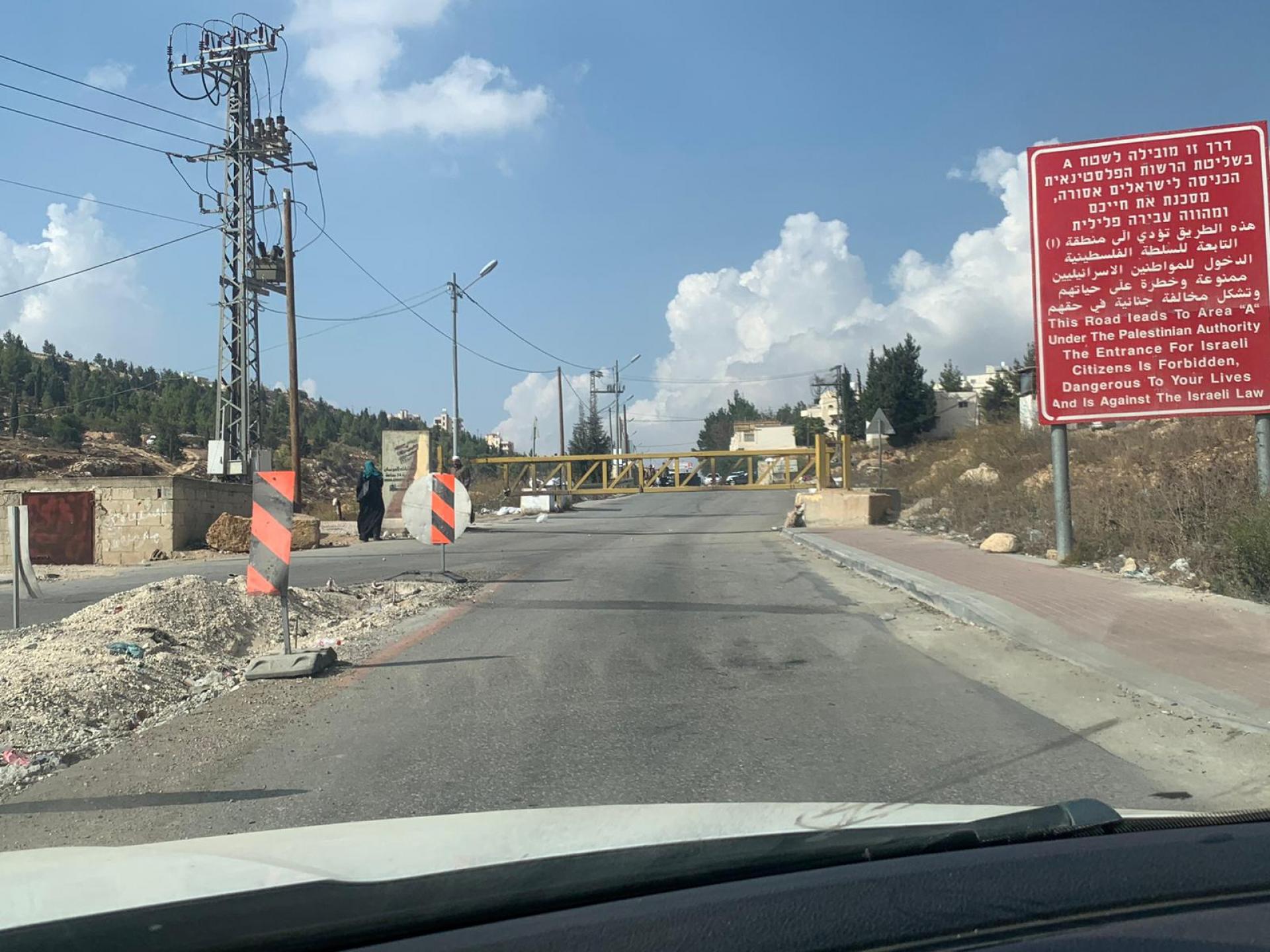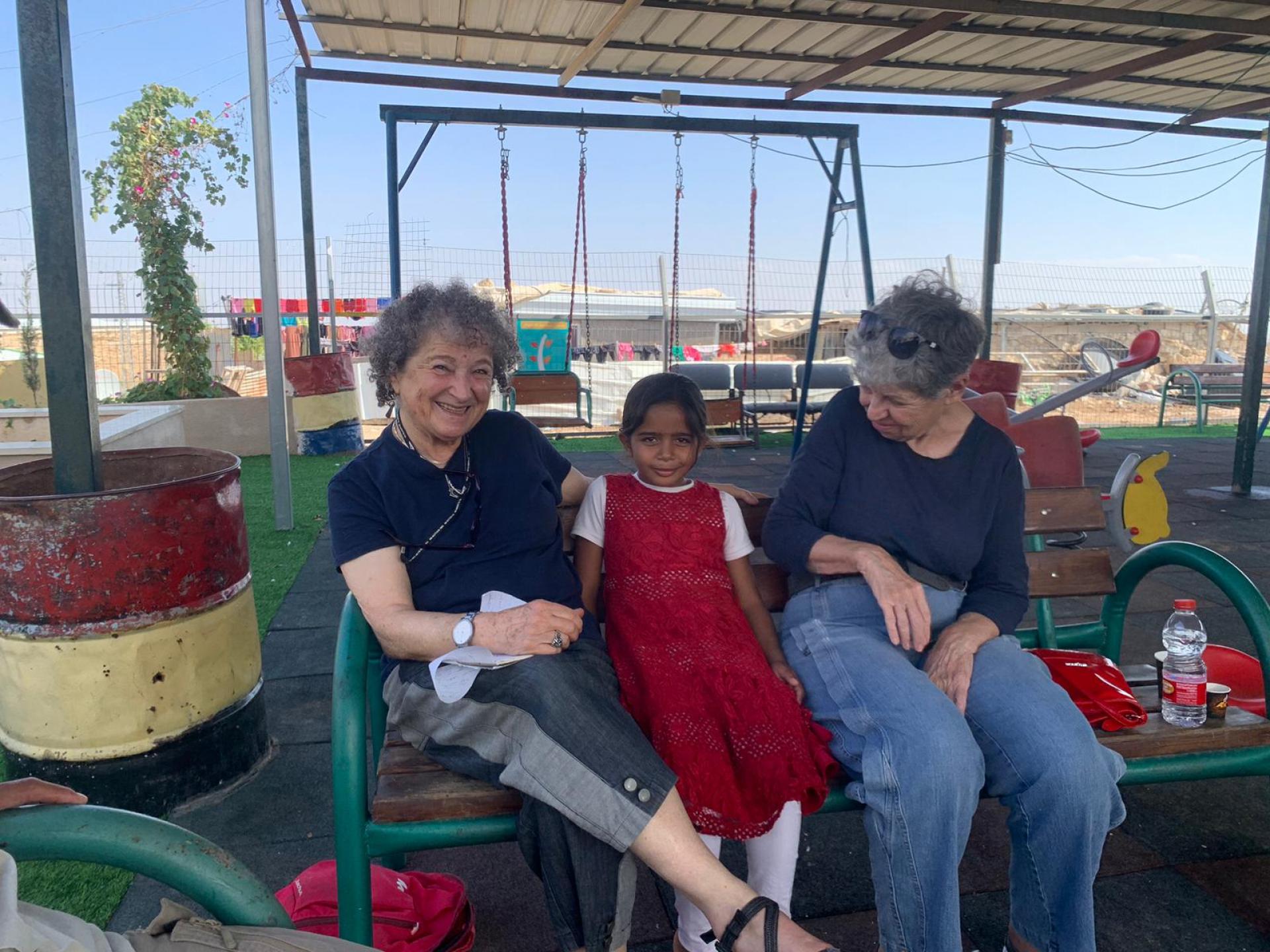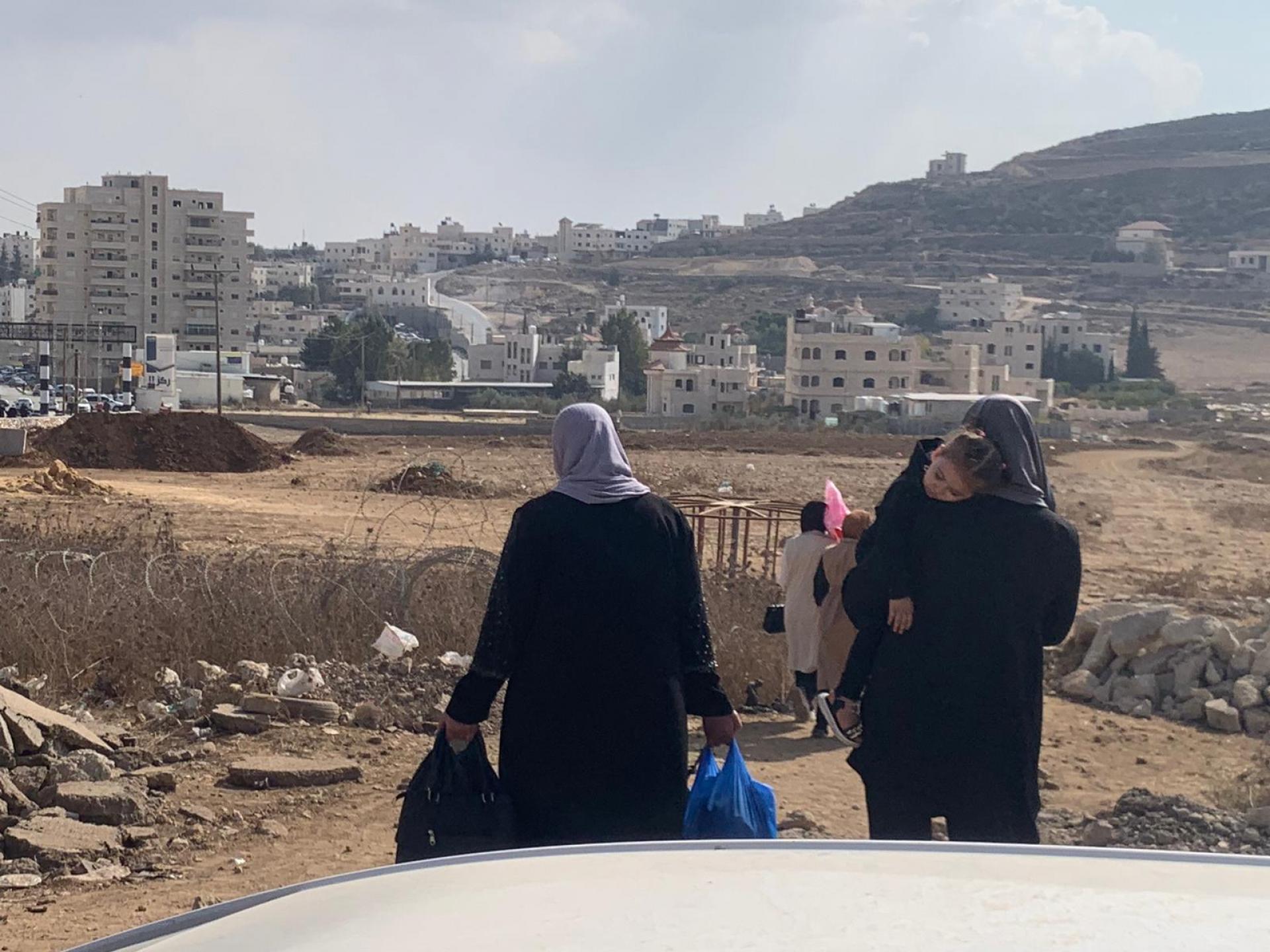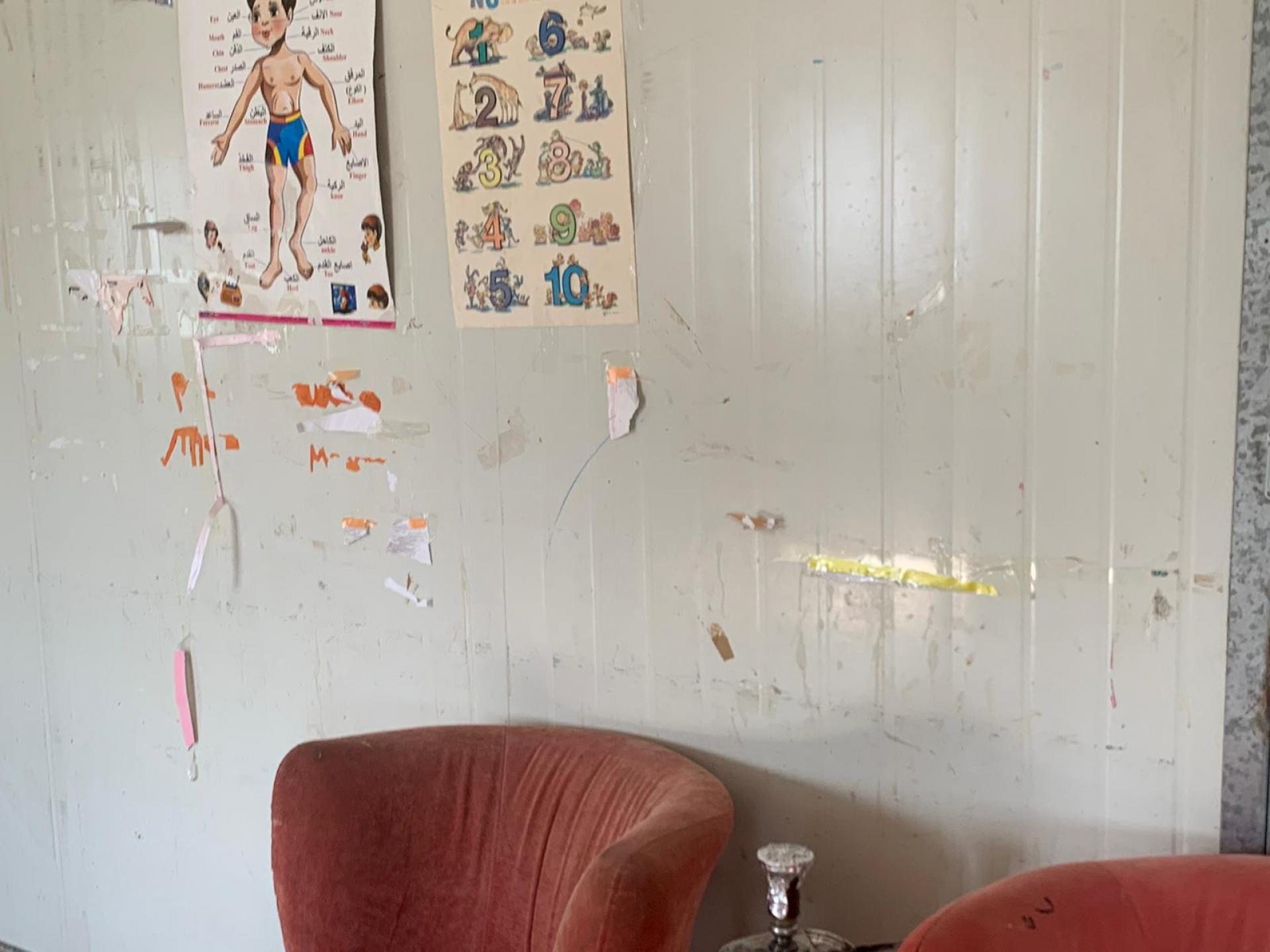Ongoing harassment by armed and uniformed colonists

We first thought we’d drive to the Jewish colony in Hebron where things are dire, but because of news of violence we changed our plans. Most of our vigil was spent visiting the village of Umm Al Khair.
Meitar Crossing/Checkpoint – the car parks are empty of course. No passage for Palestinian workers.
Road 60 – we pass by the entrance to Zanouta village, which is now empty, because of the ongoing violence of colonists. There is no barrier (for there is no more village?). Few people are loading the remainder of their structures and equipment on vehicles.
Reminder: We have written in the past about the schoolhouse built by the Challenge System in Zanouta. It was built in spite of demotions and survived the frequent harassments. Until the village was emptied now.
Road 317
There are new soil barriers along both sides of the road. Many Israeli flags. An Israeli flag waves above the burnt remains of the village Makatel Umm Salem on the northern side of the road (Amar’s family that lived there left for Samu’a). Structures under construction or tents are seen on many hills long both sides of the road. With Israeli flags. Opposite Asa’el colony we see a structure, perhaps a new ranch. Near Asa’el, on the hills on both sides of the ranch named Mikneh Yehudah (belonging to Israel Kaplan) we see Israeli flags. Perhaps these too are beginnings of new ranch outposts.
As we passed next to Abu Safi’s deserted area, as he too left for Samu’a following the murder threats by colonists, Mohammad noted that even he got back to his fields this year, the crop is already gone for this is now the time to sow.
The entrance to Yatta opposite A-Tawane looks open and there are no soldiers, but we are told that further down the road is a checkpoint.
Umm Al Khair – a harassment saga
We met both A. and H. who asked not to identify them by their full names for fear of the colonists. We have known A. for years as activists. He is self-taught, learned a fluent and rich Hebrew, is an artist and a philosopher in his thinking. We sat and talked at the center of the village – where there are a small children’s playground, several benches and structures. This is all adjacent to the fence of Carmel colony. We had a nice moment when H.’s children arrived. His daughter was born to him and his wife about ten years ago when we helped develop the kindergarten that worked here for several years. His wife was one of the kindergarten teachers. Ten years have gone by, and things have gotten much worse.
tells us about the harassment by the Israeli army and his Carmel colony neighbors:
On the morning of Sunday, October 29th, a white army pickup truck came out of the yellow gate of Carmel colony, beyond which the houses and tents of Umm Al Khair are located. It had four passengers inside, all in army uniforms, army security vests and rifles), all masked. The Palestinians think these are Carmel colonists (‘serving in the reserves’ in the colonies). The vehicle came to the village Diwan (the hospitality house). They gathered all the young men, took away their phones. Ordered them to sit opposite the wall with their hands on their heads. Then they kicked them. They also kicked the elderly man. They locked one of the women in another room. There was the sound of crying. People were forced to open their cell phones and look for incitement material and support of Hamas.
Later (or at another date, it was not clear) they rode up with the pickup truck along the Carmel fence, to the other side of Umm Al Khair. Again they gathered 16 young men in a tent, including a young boy, a child really. Again phones were collected, people were scolded and made to confess that they support Hamas. A colonist filled with hatred and ‘unprofessional’ (as A. put it) took out bullets and loaded his gun. They cocked their rifles and pointed them at people’s foreheads. Again, there were phone searches, comments, kicks. They came to A.’s home, dragged him, forced him to translate their directions to the younger guys: You must now declare that you support the State of Israel, that you are against the massacre that took place in Kibbutz Nir Oz, and they filmed them on video. They forced the kid to get up and condemn the kidnapping to Gaza. Finally, they came to the assembly hall in the center of the village, tore drawings from the wall, tore up a map of the village. They demanded that the villagers put up Israeli flags (you can go to Yatta and buy them there…), otherwise the villagers will be murdered.
Now the villagers are afraid. They have spoken with a lawyer and with Taayush (Palestinian-Israeli partnership organization). Several Israeli peace activists came to stay in the village overnight.
Schools are closed. The teachers come from Yatta and the army would not let them through.
Livelihood: A problem. All the grazing grounds in Massafer Yatta are out of bounds to Palestinians. Only the outpost flocks may graze. The Palestinians have to feed their flocks with the feed they purchase at a steep price.
In the surrounding villages: We are told about houses being demolished in Touba. Masked colonists invaded it and cut up the electricity cable. At A-Safai a house was set on fire. While we sat at Umm Al Khair they received notice of pogroms, of a house demolished at Sha’ab Al Botom, of the Jabarin family. At Abu Kabita near the fence of Yatir colony, villagers were not allowed to come out for a whole week.
A. says, whoever is violent comes masked!
Road 356 and back on road 60: All the villages are closed off. All along the road, new soil dykes have been piled and prevent reaching the road. Zif Junction is blocked with a yellow metal gate. The crossroads at Dura, Al Fawar, and Kliklis are blocked to vehicles – Palestinians have to climb the earth dykes to cross the road on foot.




